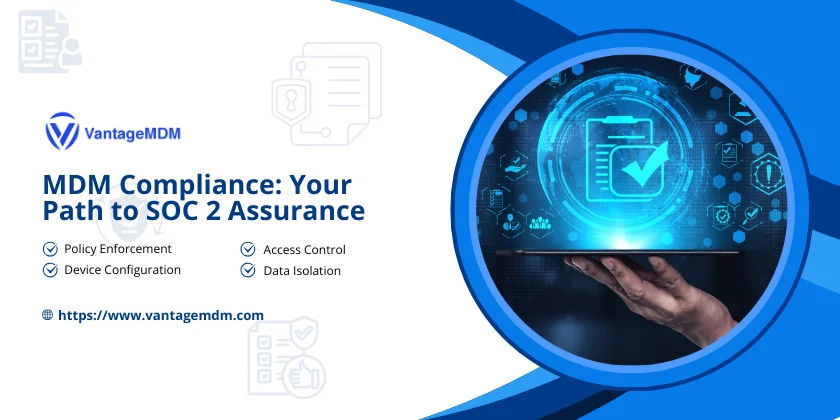How MDM Policy Can Help Organizations in Achieving SOC-2 Compliance

Enterprises are increasingly leveraging cloud computing technology to outsource their business operations to third parties for cost-effective solutions. However, this reliance on external services introduces various Advanced Persistent Threats (APTs) due to potential mismanagement of data. MDM compliance plays a vital role in addressing these challenges by ensuring that mobile devices accessing organizational data adhere to stringent security standards.
To mitigate cyber threats, System and Organization Controls 2 (SOC 2) compliance reports provide essential insights regarding an organization’s security posture. These reports assure stakeholders and customers that third-party SaaS organizations adhere to stringent security principles and are committed to protecting customer privacy and organizational interests.
SOC 2 compliance revolves around Trust Services Criteria, which encompass five key principles: confidentiality, security, integrity, availability, and processing integrity. These principles are fundamental in safeguarding organizational data.
For service organizations, SOC 2 specifies rigorous data management standards. Mobile Device Management (MDM) software plays a crucial role in meeting these trust principles, thereby enhancing an organization’s security landscape. MDM compliance solutions enable administrators to enforce policies that manage network-connected devices, sensitive data, and other critical services to mitigate cyber-attacks.
Features of MDM for SOC 2 Compliance
Security
MDM compliance policies are instrumental in protecting organizational data and resources from security breaches and unauthorized access. Key security features of MDM include:
Data Encryption
MDM software provides advanced security features such as device encryption using AES-256 or similar algorithms. This ensures that data is encrypted both at rest and in transit, safeguarding it from unauthorized access.
Password Management
MDM compliance software enforces robust password policies, ensuring devices are protected with strong, complex, and unique passwords. Policies can dictate regular password changes and enforce multi-factor authentication to enhance security further.
BYOD Management
For managing personal devices (BYOD), MDM compliance policies can implement containerization, creating a separate work profile with approved apps and configurations. This separation ensures that organizational data remains isolated and secure, preventing data transfer to personal spaces.
Network Data Security
To secure data in transit, MDM compliance policies can configure VPNs and secure Wi-Fi settings, ensuring mobile devices connect only through secure networks. This prevents data exfiltration through unsecured connections.
Kiosk Mode
MDM software can lock down devices to specific apps required for business operations. This prevents unauthorized use and ensures that only essential functionalities are accessible.
Device Configurations
To prevent data leakage, MDM compliance policies can disable functionalities such as copy-paste, screenshot capture, clipboard, Bluetooth, removable media, and NFC. Unauthorized file-sharing apps can also be blocked to limit data sharing.
Incident Response and Remediation
MDM software can remotely secure data on lost or compromised devices by locking them down. If a device is irretrievable, MDM can perform a remote wipe, either selective (deleting only corporate data) or full.
Approved Apps
Administrators can use MDM to push approved apps to devices, ensuring that only necessary applications for business operations are accessible. This also enhances security by deploying software-based firewalls to prevent unauthorized access.
Availability
Availability ensures that systems, data, and resources are accessible in a secure manner. MDM compliance contributes to availability through:
Compliance Reporting
MDM software provides automated reporting and compliance dashboards, allowing organizations to monitor device configurations, settings, and status. This helps in tracking compliance with SOC 2 and organizational policies, enabling timely remedial actions for non-compliant devices.
Monitoring
MDM monitors mobile device usage and activities, tracking login attempts, device locations, and application usage. Real-time monitoring helps organizations identify and respond to potential security threats promptly.
Device Management
MDM manages device configurations, including installing software updates, configuring settings, and detecting jailbroken/rooted devices. Promptly addressing non-conformance ensures devices remain available and secure.
Processing Integrity
Processing integrity ensures that system processes are authorized and efficient. MDM supports this through:
Access Control
MDM compliance software sets policies and controls for device usage, restricting access to certain applications and data based on user roles or device location. For example, configuring VPNs or secure network access controls restricts access to sensitive data only through secure connections.
Device Compliance
MDM enforces compliance policies, such as minimum OS version, Wi-Fi data usage, jailbreak detection, and device encryption. This ensures devices adhere to security standards, maintaining processing integrity.
Confidentiality
Confidentiality guarantees that sensitive data remains protected. MDM compliance supports this through:
Access Management and Encryption
MDM policies restrict data access based on need, authority, and role, implementing the principle of least privilege. Data is protected using encryption algorithms, VPN technology, and pre-configured Wi-Fi networks, preserving confidentiality.
Privacy
Privacy ensures that personal data is processed within defined boundaries. MDM achieves this through:
Containerization
MDM creates a secure container on devices where corporate data and apps are stored. This container is secured with a passcode or biometric authentication, and data is encrypted to prevent unauthorized access. MDM policies control access to this container, ensuring corporate data is managed securely while personal data remains private.
In summary, MDM compliance software is integral to achieving SOC 2 compliance, helping organizations protect their data through robust security, availability, processing integrity, confidentiality, and privacy measures. By implementing comprehensive MDM policies, enterprises can safeguard their digital environments against potential threats, ensuring compliance and enhancing overall security posture.
By adhering to these principles and leveraging MDM compliance software, organizations can ensure MDM compliance, maintaining a robust security framework that supports SOC 2 requirements. The implementation of effective MDM policies not only enhances data protection but also fortifies the trust of stakeholders and customers in the organization's commitment to security and privacy.